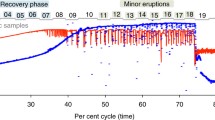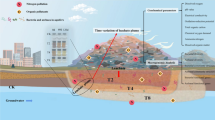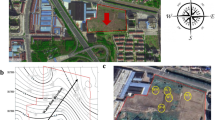Abstract
Advances in our understanding of the microbial ecology at sites impacted by light non-aqueous phase liquids (LNAPLs) are needed to drive development of optimized bioremediation technologies, support longevity models, and develop culture-independent molecular tools. In this study, depth-resolved characterization of geochemical parameters and microbial communities was conducted for a shallow hydrocarbon-impacted aquifer. Four distinct zones were identified based on microbial community structure and geochemical data: (i) an aerobic, low-contaminant mass zone at the top of the vadose zone; (ii) a moderate to high-contaminant mass, low-oxygen to anaerobic transition zone in the middle of the vadose zone; (iii) an anaerobic, high-contaminant mass zone spanning the bottom of the vadose zone and saturated zone; and (iv) an anaerobic, low-contaminant mass zone below the LNAPL body. Evidence suggested that hydrocarbon degradation is mediated by syntrophic fermenters and methanogens in zone III. Upward flux of methane likely contributes to promoting anaerobic conditions in zone II by limiting downward flux of oxygen as methane and oxygen fronts converge at the top of this zone. Observed sulfate gradients and microbial communities suggested that sulfate reduction and methanogenesis both contribute to hydrocarbon degradation in zone IV. Pyrosequencing revealed that Syntrophus- and Methanosaeta-related species dominate bacterial and archaeal communities, respectively, in the LNAPL body below the water table. Observed phylotypes were linked with in situ anaerobic hydrocarbon degradation in LNAPL-impacted soils.





Similar content being viewed by others
References
Abed RMM, Safi NMD, Koster J, de Beer D, El-Nahhal Y, Rullkotter J, Garcia-Pichel F (2002) Microbial diversity of a heavily polluted microbial mat and its community changes following degradation of petroleum compounds. App Environ Microbiol 68(4):1674–1683. doi:10.1128/aem.68.4.1674-1683.2002
Abu Laban N, Selesi D, Rattei T, Tischler P, Meckenstock RU (2010) Identification of enzymes involved in anaerobic benzene degradation by a strictly anaerobic iron-reducing enrichment culture. Environ Microbiol 12(10):2783–2796. doi:10.1111/j.1462-2920.2010.02248.x
Aburto A, Peimbert M (2011) Degradation of a benzene-toluene mixture by hydrocarbon-adapted bacterial communities. Ann Microbiol 61(3):553–562. doi:10.1007/s13213-010-0173-6
Acosta‐González A, Rosselló‐Móra R, Marqués S (2013) Characterization of the anaerobic microbial community in oil‐polluted subtidal sediments: aromatic biodegradation potential after the Prestige oil spill. Environ Microbiol 15(1):77–92
Bakermans C, Madsen EL (2002) Diversity of 16S rDNA and naphthalene dioxygenase genes from coal-tar-waste-contaminated aquifer waters. Microb Ecol 44(2):95–106. doi:10.1007/s00248-002-0005-8
Bates ST, Berg-Lyons D, Caporaso JG, Walters WA, Knight R, Fierer N (2011) Examining the global distribution of dominant archaeal populations in soil. ISME J 5(5):908–917. doi:10.1038/ismej.2010.171
Chadalavada S, Datta B, Naidu R (2012) Optimal identification of groundwater pollution sources using feedback monitoring information: a case study. Environ Forensics 13(2):140–153. doi:10.1080/15275922.2012.676147
Clarke KR (1993) Non‐parametric multivariate analyses of changes in community structure. Aus J Ecol 18(1):117–143
Das N, Chandran P (2010) Microbial degradation of petroleum hydrocarbon contaminants: an overview. Biotechnol Res Int 2011. doi:10.4061/2011/941810
Declercq I, Cappuyns V, Duclos Y (2012) Monitored natural attenuation (MNA) of contaminated soils: state of the art in Europe—a critical evaluation. Sci Total Environ 426:393–405
DeJong T (1975) A comparison of three diversity indices based on their components of richness and evenness. Oikos 222–227
Dojka MA, Hugenholtz P, Haack SK, Pace NR (1998) Microbial diversity in a hydrocarbon- and chlorinated-solvent-contaminated aquifer undergoing intrinsic bioremediation. Appl Environ Microbiol 64(10):3869–3877
dos Santos HF, Cury JC, do Carmo FL, dos Santos AL, Tiedje J, van Elsas JD, Rosado AS, Peixoto RS (2011) Mangrove bacterial diversity and the impact of oil contamination revealed by pyrosequencing: bacterial proxies for oil pollution. PLoS One 6(3), e16943. doi:10.1371/journal.pone.0016943
Edgar RC (2010) Search and clustering orders of magnitude faster than BLAST. Bioinformatics 26(19):2460–2461. doi:10.1093/bioinformatics/btq461
Elshahed MS, Bhupathiraju VK, Wofford NQ, Nanny MA, McInerney MJ (2001) Metabolism of benzoate, cyclohex-1-ene carboxylate, and cyclohexane carboxylate by “Syntrophus aciditrophicus” strain SB in syntrophic association with H-2-using microorganisms. Appl Environ Microbiol 67(4):1728–1738. doi:10.1128/aem.67.4.1728-1738.2001
Evans PN, Hinds LA, Sly LI, McSweeney CS, Morrison M, Wright A-DG (2009) Community composition and density of methanogens in the foregut of the Tammar wallaby (Macropus eugenii). Appl Environ Microbiol 75(8):2598–2602
Fahrenfeld N, Cozzarelli IM, Bailey Z, Pruden A (2014) Insights into biodegradation through depth-resolved microbial community functional and structural profiling of a crude-oil contaminant plume. Microbial Ecol 68(3):453–462. doi:10.1007/s00248-014-0421-6
Fardeau ML, Magot M, Patel BKC, Thomas P, Garcia JL, Ollivier B (2000) Thermoanaerobacter subterraneus sp nov., a novel thermophile isolated from oilfield water. Int J Syst Evol Microbiol 50:2141–2149
Ghazali FM, Rahman R, Salleh AB, Basri M (2004) Biodegradation of hydrocarbons in soil by microbial consortium. Int Biodeterior Biodegrad 54(1):61–67. doi:10.1016/j.ibiod.2004.02.002
Glatz BA, Goepfert J (1976) Defined conditions for synthesis of Bacillus cereus enterotoxin by fermenter-grown cultures. Appl Environ Microbiol 32(3):400–404
Hao OJ, Chen M, Huang L, Buglass RL (1996) Sulfate-reducing bacteria. Crit Rev Environ Sci Technol 26(1):155–187
Haynes CA, Gonzalez R (2014) Rethinking biological activation of methane and conversion to liquid fuels. Nat Chem Biol 10(5):331–339
Hers I, Jourabchi P, Lahvis MA, Dahlen P, Luo EH, Johnson P, DeVaull GE, Mayer KU (2014) Evaluation of seasonal factors on petroleum hydrocarbon vapor biodegradation and intrusion potential in a cold climate. Groundw Monit Remediat 34(4):60–78
Huang YX, Li L (2014) Biodegradation characteristics of naphthalene and benzene, toluene, ethyl benzene, and xylene (BTEX) by bacteria enriched from activated sludge. Water Environ Res 86(3):277–284. doi:10.2175/106143013x13807328849495
Huntley D, Beckett GD (2002) Persistence of LNAPL sources: relationship between risk reduction and LNAPL recovery. J Contam Hydrol 59(1–2):3–26. doi:10.1016/s0169-7722(02)00073-6
Illman WA, Alvarez PJ (2009) Performance assessment of bioremediation and natural attenuation. Crit Rev Environ Sci Technol 39(4):209–270
Jackson BE, Bhupathiraju VK, Tanner RS, Woese CR, McInerney MJ (1999) Syntrophus aciditrophicus sp. nov., a new anaerobic bacterium that degrades fatty acids and benzoate in syntrophic association with hydrogen-using microorganisms. Arch Microbiol 171(2):107–114. doi:10.1007/s002030050685
Jennings ME, Schaff CW, Horne AJ, Lessner FH, Lessner DJ (2014) Expression of a bacterial catalase in a strictly anaerobic methanogen significantly increases tolerance to hydrogen peroxide but not oxygen. Microbiology 160(Pt 2):270–278
Jørgensen KS, Salminen JM, Björklöf K (2010) Monitored natural attenuation. Bioremediation. Springer, pp 217–233
Jung M-Y, Park S-J, Min D, Kim J-S, Rijpstra WIC, Damsté JSS, Kim G-J, Madsen EL, Rhee S-K (2011) Enrichment and characterization of an autotrophic ammonia-oxidizing archaeon of mesophilic crenarchaeal group I. 1a from an agricultural soil. Appl Environ Microbiol 77(24):8635–8647
Karimi B, Habibi M, Esvand M (2015) Biodegradation of naphthalene using Pseudomonas aeruginosa by up flow anoxic-aerobic continuous flow combined bioreactor. J Environ Health Sci Eng 13. doi:10.1186/s40201-015-0175-1
Kleikemper J, Pombo SA, Schroth MH, Sigler WV, Pesaro M, Zeyer J (2005) Activity and diversity of methanogens in a petroleum hydrocarbon-contaminated aquifer. Appl Environ Microbiol 71(1):149–158
Kleinsteuber S, Schleinitz KM, Breitfeld J, Harms H, Richnow HH, Vogt C (2008) Molecular characterization of bacterial communities mineralizing benzene under sulfate-reducing conditions. FEMS Microbiol Ecol 66(1):143–157. doi:10.1111/j.1574-6941.2008.00536.x
Kleinsteuber S, Schleinitz KM, Vogt C (2012) Key players and team play: anaerobic microbial communities in hydrocarbon-contaminated aquifers. Appl Microbiol Biotechnol 94(4):851–873. doi:10.1007/s00253-012-4025-0
Landmeyer J, Chapelle F, Petkewich M, Bradley P (1998) Assessment of natural attenuation of aromatic hydrocarbons in groundwater near a former manufactured-gas plant, South Carolina, USA. Environ Geol 34(4):279–292
Liu R, Zhang Y, Ding R, Li D, Gao Y, Yang M (2009) Comparison of archaeal and bacterial community structures in heavily oil-contaminated and pristine soils. J Biosci Bioeng 108(5):400–407
Luo F, Gitiafroz R, Devine CE, Gong YC, Hug LA, Raskin L, Edwards EA (2014) Metatranscriptome of an anaerobic benzene-degrading, nitrate-reducing enrichment culture reveals involvement of carboxylation in benzene ring activation. Appl Environ Microbiol 80(14):4095–4107. doi:10.1128/aem.00717-14
Mason OU, Han J, Woyke T, Jansson JK (2014) Single-cell genomics reveals features of a Colwellia species that was dominant during the Deepwater Horizon oil spill. Front Microbiol 5. doi:10.3389/fmicb.2014.00332
McCoy K, Zimbron J, Sale T, Lyverse M (2014) Measurement of natural losses of LNAPL using CO2 traps. Groundwater 53(4):658–667. doi:10.1111/gwat.12240
McInerney MJ, Rohlin L, Mouttaki H, Kim U, Krupp RS, Rios-Hernandez L, Sieber J, Struchtemeyer CG, Bhattacharyya A, Campbell JW (2007) The genome of Syntrophus aciditrophicus: life at the thermodynamic limit of microbial growth. Proc Natl Acad Sci U S A 104(18):7600–7605
Morris BE, Herbst FA, Bastida F, Seifert J, von Bergen M, Richnow HH, Suflita JM (2012) Microbial interactions during residual oil and n‐fatty acid metabolism by a methanogenic consortium. Environ Microbiol Rep 4(3):297–306
Mountfort D, Brulla W, Krumholz LR, Bryant M (1984) Syntrophus buswellii gen. nov., sp. nov.: a benzoate catabolizer from methanogenic ecosystems. Int J Syst Bacteriol 34(2):216–217
Narihiro T, Sekiguchi Y (2011) Oligonucleotide primers, probes and molecular methods for the environmental monitoring of methanogenic archaea. Microbial Biotechnol 4(5):585–602
Newman WA, Kimball G, Consultants DE (1991) Dissolved oxygen mapping: a powerful tool for site assessments and ground water monitoring. In: Proceedings of the Fifth National Outdoor Action Conference on Aquifer Restoration, Ground Water Monitoring, and Geophysical Methods
Ortega-Calvo J-J, Alexander M (1994) Roles of bacterial attachment and spontaneous partitioning in the biodegradation of naphthalene initially present in nonaqueous-phase liquids. Appl Environ Microbiol 60(7):2643–2646
Plugge CM, Zhang W, Scholten JCM, Stams AJM (2011) Metabolic flexibility of sulfate-reducing bacteria. Front Microbiol 2:1–8. doi:10.3389/fmicb.2011.00081
Polissi A, Bestetti G, Bertoni G, Galli E, Deho G (1990) Genetic analysis of chromosomal operons involved in degradation of aromatic hyrocarbons in Pseudomonas putida TMB. J Bacteriol 172(11):6355–6362
Ravot G, Ollivier B, Magot M, Patel B, Crolet J, Fardeau M, Garcia J (1995) Thiosulfate reduction, an important physiological feature shared by members of the order thermotogales. Appl Environ Microbiol 61(5):2053–2055
ITRC (Interstate Technology & Regulatory Council) (2009a) Evaluating LNAPL remedial technologies for achieving project goals. LNAPL-2. Interstate Technology & Regulatory Council, LNAPLs Team, Washington, D.C. www.itrcweb.org
ITRC (Interstate Technology & Regulatory Council) (2009b) Evaluating natural source zone depletion at sites with LNAPL. LNAPL-1. Interstate Technology & Regulatory Council, LNAPLs Team, Washington, D.C. www.itrcweb.org
Roggemans S, Bruce CL, Johnson PC, Johnson RL (2001) Vadose zone natural attenuation of hydrocarbon vapors: an empirical assessment of soil gas vertical profile data. API Soil and Water Research Bulletin 15
Roh JW, Bang JH, Nam DH (1992) Nutritional requirements of Lysobacter lactamgenus for the production of cephabacins. Biotechnol Lett 14(6):455–460
Roy S, Vishnuvardhan M, Das D (2014) Improvement of hydrogen production by newly isolated Thermoanaerobacterium thermosaccharolyticum IIT BT-ST1. Int J Hydrog Energy 39(14):7541–7552. doi:10.1016/j.ijhydene.2013.06.128
Sakai N, Kurisu F, Yagi O, Nakajima F, Yamamoto K (2009) Identification of putative benzene-degrading bacteria in methanogenic enrichment cultures. J Biosci Bioeng 108(6):501–507. doi:10.1016/j.jbiosc.2009.06.005
Salamanca D, Engesser KH (2014) Isolation and characterization of two novel strains capable of using cyclohexane as carbon source. Environ Sci Pollut Res 21(22):12757–12766. doi:10.1007/s11356-014-3206-z
Sale T (2003) Answers to frequently asked questions about managing risk at LNAPL sites. API Soil and Water Research Bulletin (18): 1–20
Seagren EA, Rittmann BE, Valocchi AJ (2002) Bioenhancement of NAPL pool dissolution: experimental evaluation. J Contam Hydrol 55(1):57–85
Siddique T, Penner T, Semple K, Foght JM (2011) Anaerobic biodegradation of longer-chain n-alkanes coupled to methane production in oil sands tailings. Environ Sci Technol 45(13):5892–5899
Sieber JR, McInerney MJ, Gunsalus RP (2012) Genomic insights into syntrophy: the paradigm for anaerobic metabolic cooperation. Annu Rev Microbiol 66:429–452
Simarro R, González N, Bautista LF, Molina MC (2013) Biodegradation of high‐molecular‐weight polycyclic aromatic hydrocarbons by a wood‐degrading consortium at low temperatures. FEMS Microbiol Ecol 83(2):438–449
Singh S, Sarma PM, Lal B (2014) Biohydrogen production by Thermoanaerobacterium thermosaccharolyticum TERI S7 from oil reservoir flow pipeline. Int J Hydrog Energy 39(9):4206–4214. doi:10.1016/j.ijhydene.2013.12.179
Singleton DR, Ramirez LG, Aitken MD (2009) Characterization of a polycyclic aromatic hydrocarbon degradation gene cluster in a phenanthrene-degrading Acidovorax strain. Appl Environ Microbiol 75(9):2613–2620. doi:10.1128/aem.01955-08
Sun MY, Dafforn KA, Johnston EL, Brown MV (2013) Core sediment bacteria drive community response to anthropogenic contamination over multiple environmental gradients. Environ Microbiol 15(9):2517–2531. doi:10.1111/1462-2920.12133
Sutton NB, Maphosa F, Morillo JA, Abu Al-Soud W, Langenhoff AAM, Grotenhuis T, Rijnaarts HHM, Smidt H (2013) Impact of long-term diesel contamination on soil microbial community structure. Appl Environ Microbiol 79(2):619–630. doi:10.1128/aem.02747-12
Suzuki MT, Taylor LT, DeLong EF (2000) Quantitative analysis of small-subunit rRNA genes in mixed microbial populations via 5′-nuclease assays. Appl Environ Microbiol 66(11):4605–4614
Tischer K, Kleinsteuber S, Schleinitz KM, Fetzer I, Spott O, Stange F, Lohse U, Franz J, Neumann F, Gerling S, Schmidt C, Hasselwander E, Harms H, Wendeberg A (2013) Microbial communities along biogeochemical gradients in a hydrocarbon-contaminated aquifer. Environ Microbiol 15(9):2603–2615. doi:10.1111/1462-2920.12168
Viñas M, Sabaté J, Espuny MJ, Solanas AM (2005) Bacterial community dynamics and polycyclic aromatic hydrocarbon degradation during bioremediation of heavily creosote-contaminated soil. Appl Environ Microbiol 71(11):7008–7018
Vogt C, Kleinsteuber S, Richnow HH (2011) Anaerobic benzene degradation by bacteria. Microbial Biotechnol 4(6):710–724. doi:10.1111/j.1751-7915.2011.00260.x
Wang LY, Ke WJ, Sun XB, Liu JF, Gu JD, Mu BZ (2014) Comparison of bacterial community in aqueous and oil phases of water-flooded petroleum reservoirs using pyrosequencing and clone library approaches. Appl Microbiol Biotechnol 98(9):4209–4221. doi:10.1007/s00253-013-5472-y
Ward NL, Challacombe JF, Janssen PH, Henrissat B, Coutinho PM, Wu M, Xie G, Haft DH, Sait M, Badger J (2009) Three genomes from the phylum Acidobacteria provide insight into the lifestyles of these microorganisms in soils. Appl Environ Microbiol 75(7):2046–2056
Whitby C, Lund ST (2009) Applied microbiology and molecular biology in oil field systems. Springer, Netherlands
Winderl C, Anneser B, Griebler C, Meckenstock RU, Lueders T (2008) Depth-resolved quantification of anaerobic toluene degraders and aquifer microbial community patterns in distinct redox zones of a tar oil contaminant plume. Appl Environ Microbiol 74(3):792–801. doi:10.1128/aem.01951-07
Worsey MJ, Williams PA (1975) Metabolism of toluene and xylenes by Pseudomonas putida (arvilla) mt-2: evidence for a new function of TOL plasmid. J Bacteriol 124(1):7–13
Wu Y, Luo Y, Zou D, Ni J, Liu W, Teng Y, Li Z (2008) Bioremediation of polycyclic aromatic hydrocarbons contaminated soil with Monilinia sp.: degradation and microbial community analysis. Biodegradation 19(2):247–257
Zeman NR, Renno MI, Olson MR, Wilson LP, Sale TC, De Long SK (2014) Temperature impacts on anaerobic biotransformation of LNAPL and concurrent shifts in microbial community structure. Biodegradation 25(4):569–585. doi:10.1007/s10532-014-9682-5
Zengler K, Richnow HH, Rossello-Mora R, Michaelis W, Widdel F (1999) Methane formation from long-chain alkanes by anaerobic microorganisms. Nature 401(6750):266–269
Zhalnina KV, Dias R, Leonard MT, de Quadros PD, Camargo FA, Drew JC, Farmerie WG, Daroub SH, Triplett EW (2014) Genome sequence of Candidatus Nitrososphaera evergladensis from group I. 1b enriched from Everglades soil reveals novel genomic features of the ammonia-oxidizing archaea. PLoS One 9(7), e101648
Acknowledgments
Funding for this work was provided by Chevron, Exxon Mobil, and the National Science Foundation via an Alliance for the Graduate Education and Professoriate (AGEP) fellowship awarded to M. Irianni - Renno. The authors would like to thank site consultants from TriHydro Inc., Alysha Hakala, Thomas Gardner, Stephanie Whitfield, Shawn Harshman, and Ben McAlexander, for their technical support in the field.
Author information
Authors and Affiliations
Corresponding author
Ethics declarations
This article does not contain any studies with human participants or animals performed by any of the authors.
Funding
This study was funded by Chevron and Exxon Mobil and by the US National Science Foundation via an Alliance for the Graduate Education and Professoriate (AGEP) fellowship awarded to M. Irianni - Renno.
Conflict of interest
M. Irianni - Renno declares she has no conflict of interest. D. Akhbari declares he has no conflict of interest. M.R. Olson declares he has no conflict of interest. A.P. Byrne declares he has no conflict of interest. E. Lefevre declares she has no conflict of interest. J. Zimbron declares he has no conflict of interest. M. Lyverse declares he has no conflict of interest. T.C. Sale declares he has no conflict of interest. S.K. De Long declares she has no conflict of interest.
Electronic supplementary material
Below is the link to the electronic supplementary material.
ESM 1
(PDF 1.76 MB)
Rights and permissions
About this article
Cite this article
Irianni-Renno, M., Akhbari, D., Olson, M.R. et al. Comparison of bacterial and archaeal communities in depth-resolved zones in an LNAPL body. Appl Microbiol Biotechnol 100, 3347–3360 (2016). https://doi.org/10.1007/s00253-015-7106-z
Received:
Revised:
Accepted:
Published:
Issue Date:
DOI: https://doi.org/10.1007/s00253-015-7106-z




